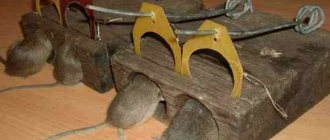DIY rat poison
The main advantage of poisons for rats is the rapid removal, thanks to them, of a large number of individuals of dangerous mammals.
There are two types of baits that are poisonous to rats:
- long-term exposure;
- fast-acting.
Physically strong, fast, well-adapted, not picky about food, a fast-reproducing animal that can fight back even a human.
In many situations, it is better to use poisons of the first type: in this case, all the bees will peck at the bait, because they will be convinced that nothing harm has come to the main “taster”.
It is good to use fast-acting poison if the rat is alone.
If we are talking about a poison of long-term exposure, then after being placed around the house it acts autonomously. It is necessary to check the portions from time to time, and if necessary, as the rats eat, add “treats”.
How is everything done in practice? For example, if six rats have settled in a dwelling, then after feasting on poisonous food at night, they should die at the same time.
The most effective folk remedies for fighting rats at home are the result of centuries-old observations of the habits, behavior and way of life of these rodents.
On the 3rd - 4th day after the rodent first tried the poisonous bait, it dies. These mammals are unable to distinguish the presence of toxic substances in treats by smell. Before receiving a lethal dose, the rat does not feel any signs of poisoning. Therefore, pests do not develop wariness towards such baits, there is no need to avoid the treat, and the animals are quite actively poisoned.
After seven to ten days, there will be no more household pests in your home.
IMPORTANT! They place poisons in those locations where pests are most likely to find them.
To prepare your own poison for rats, you should take:
- alabaster;
- water;
- flour.
Construction plaster along with flour (1:1) is poured into a container. A bowl filled with water is placed next to it. Having “treated” to the mixture from the container, the animal will drink its “food”. Soon almost cement will form in the stomach, and the animal will have terrible indigestion.
Construction plaster and corn flour (in equal proportions) are thoroughly mixed and laid out in the places most visited by rats, and a bowl of water is placed next to it.
Another popular recipe. For rats, leave bait prepared from the following ingredients: take ¼ cup of sugar and soda, 150 g of flour. Everything gets mixed up. Having tasted the “food”, the animal will be poisoned, since a dangerous gas will begin to be produced in its stomach.
ADDITIONAL INFORMATION! You can poison harmful animals in such a way as to cause oxygen starvation in them, and they run away from home.
In the stomach of a rat, soda reacts with hydrochloric acid, resulting in the release of carbon dioxide.
Often, rat passages in private homes are moistened with denatured alcohol, kerosene, vinegar (as an option, they are plugged with rags, which are moistened with a liquid harmful to the rodent).
How to get rid of rats in the house: 5 basic methods
Scientists identify the following effective methods for controlling rats: changing the habitat, scaring them away, and exterminating them. We list the 5 most popular ways to get rid of such unpleasant neighbors:
- Use poison. Slowly but steadily poison the rodents using poison baits and hope that they go to die far from your home.
- Set up rat traps or electronic traps. In the first case, you will need to manually throw out the corpses, and in the second, simply shake out the contents into the trash can.
- Drive them out using electronic ultrasonic repellers. Such repellers can be placed both in an apartment and a private house.
- Use natural repellents around the perimeter of the house: sprays, granules and special sachets.
- Try traditional methods.
Rat poison: features of use in the home
Poisoned baits (rodenticides) are the most optimal way to massively and quickly destroy tailed creatures. They are divided into 2 categories: chronic poisons (contain anticoagulants) and acute poisons. The former (including bromadiolone, brodifacoum) disrupt the blood's ability to clot, causing bleeding - as a result, rodents die from internal hemorrhages. The latter are no less toxic, but act differently: they lead to kidney, liver or other failure, and then to death.
Poisons can have a cumulative effect or kill immediately after the first dose - it all depends on the specific brand of poison and the active ingredient. Typically, poisons containing anticoagulants take from several days to a couple of weeks to kill all pests. But no one knows where exactly each rat will eventually die - it can happen either in your home or on the street, if you're lucky.
In addition, poisonous baits should not be left indoors near small children and pets, who may naively try and eat the “candy” lying on the floor. It is better to place such products exactly where you saw rodents, and not allow anyone there. Be sure to use gloves when handling rat poison—rodents may be deterred by the human scent.
What poisons are most common today? The so-called “second generation” poisons based on brodifacoum and bromadiolone, which require only a single feeding. Most popular products:
Remedy for rats and mice “Shoo”
“KYSH” is a rodenticide in the form of a soft dough-like mass in a 100 g bag. The active component is brodifacoum. With the help of this bait, you can get rid of unnecessary rodents in your house in the shortest possible time - and it costs only 145 rubles.
Price: 145 rub.
Bait granules “Help”
Bait granules “Help” are granules based on bromadiolone. A pack of 200 g allows you to quickly scatter the granules in any part of the house. Also suitable for getting rid of moles and mice. A universal budget choice for 29 rubles.
Price: 29 rub.
Bait granules Ratron
Bait granules “Ratron” for killing rats and mice are a more expensive rodenticide from Germany for 409 rubles (5 bags of 40 g of poison). The active ingredient is brodifacoum. Users note that the bait is so attractive to rodents that they find it themselves, chew through the packaging, eat it and die.
Price: 429 rub.
Killing rats with traps
Despite the fact that electronic rodent traps are becoming increasingly popular these days, the most popular are traditional spring mouse traps (rat traps) and sticky traps for rodents and insects.
If you don’t have too many rodents in your apartment, then start with simple traps - they are quite effective, although this is considered a rather cruel way to exterminate pests. Use a traditional mousetrap with bait - if there is only one rat running around, you can solve the problem fairly quickly. These devices are very budget-friendly - the standard version, like a metal rat trap, can be bought for only 99 rubles
Making traps
Traps are great for methodically controlling rats in your home. At the same time, using traps together with baits, rodents can be caught in almost any room.
Placed traps and traps work for sure, which should lead to the rapid destruction of rodents.
It is possible to make such stations for catching animals using improvised means. Thus, the solution to the problem - getting rid of rats - will not hit your pocket hard.
NOTE! Often, self-made traps are no worse in operation than industrially produced options.
Having decided to fight rats in a private home using physical means, you need to carefully study their paths of movement in order to place traps and rat traps in the places most frequently visited by rats.
So, in the conditions of a house (apartment) it is easy to make a very effective live trap. You will need:
- deep container;
- 2 – 3 planks;
- thick wire.
What is the task? A tilting bridge is made from one plank and wire. Place bait on the edge of the bridge and place it on the prepared container. Next, an improvised staircase is made to the structure. The animal will use it to get to the edge of the container. As soon as the rat tries to approach the “treat,” the bridge will tip over and the rodent will fall into the container.
Products that will arouse interest in rodents are placed in the rat trap: smoked meat, cheese, sausage.
It is useful to do the following two things with this device:
- water is poured into the container (the rat should not be able to jump out by pushing off from the bottom);
- the bait is attached to the bridge (after the rat falls into the container, the structure will be able to catch the animals again, returning to its original position).
There is a fairly common version of glue traps.
Approaching the bait, the animal is literally glued and is no longer able to free itself.
Such traps are made of plastic or cardboard. Pest control glue is applied to the surface of the material.
NOTE! Traps are not a suitable option in such situations when the task is to remove many mice or rats at once, and do it as quickly as possible. In this case, poisons for rodents can come to the rescue.
What folk remedies repel rats?
It is not uncommon for a situation to arise when the use of chemical components and toxic substances to control rodents is impossible or undesirable. In this case, traditional methods are used. With their competent and comprehensive use, you can achieve the desired result. They will not help only when the pest population has reached critical levels. In such a situation, you should immediately contact a professional service.
Let's consider what folk remedies repel rats, help organize an effective protective barrier, and can be used as preventive measures.
Plants and herbs
Plants with a pungent odor have long been used by humans to combat parasites and pests. They are also suitable for repelling rats. The following plants have gained the most popularity:
- Blackroot
is a poisonous herb that releases alkaloids. The root is used to repel rodents. Its juice can kill the nervous system of an animal. - Cilantro.
The essential oils of the plant are excellent at repelling rats. - Pharmaceutical chamomile, calendula, daffodils.
Flowers can be planted in the garden and hung at home, fresh or dried. - The smell of tansy and peppermint
has an irritating effect on rodents. - Tomato tops
have a specific aroma due to the presence of toxic substances in the juice. A simple way to use it is to cut the tops into small pieces and spread them around the perimeter of the house.
There are several options for using plants with a tart aroma. You can hang bunches of fresh or dried herbs around the house, prepare an alcohol tincture or decoction and treat all surfaces in the room with the solution. Essential oils from plants exude a particularly concentrated odor. To use it, pieces of fabric or cotton pads are soaked in a fragrant squeeze, scattered near rat holes and in places where they are likely to appear.
Mechanical traps
Mechanical traps include traps, slippery and water baits, mousetraps and other devices that are designed to catch pests. They have a basic operating principle and are easy to use. A bait with poison is placed in the center of the trap. The rat, approaching her, falls into a trap from which it is unable to get out. This could be an adhesive fixation, a holding mechanism, or some other trap.
This method is suitable only for the destruction of single individuals. The owner of the site will have to inspect the traps every day, remove corpses and update the bait.
Other folk methods
To fight rats, you can use improvised means, one of which can be found in the house or at your dacha:
- Alabaster, plaster.
It is necessary to make a bait by adding flour or other food attractive to rats to the substance. Place the resulting mixture in places where rodents are most likely to appear. The gypsum in the stomach will harden, which will lead to the death of the animal. - A mixture of putty and semolina.
The principle of operation is similar to the method using gypsum. - A mixture of soda, flour and sugar.
If a rat eats the bait, gas will begin to form in the stomach, which will kill the animal.
Advice.
Separately, it is worth mentioning the installation of ultrasonic traps. Its action is based on the irritating effect of the waves emanating from the device. Humans cannot hear them, but rats perceive sound very keenly and try to run away.
Ultrasonic repeller
This method of control is good for the following: thanks to a repeller that affects rats with ultrasound, you can get rid of them in the house without killing them. In this case, there is no need to contact them at all. The device generates high-frequency sounds, the rats begin to feel discomfort, and therefore try to leave their favorite home.
Electronic and ultrasonic rat and mouse repellers have been used in everyday life for quite some time.
But ultrasonic signals are not audible to humans (his ears simply cannot distinguish them). This means that how the device works in a home environment is almost invisible to people.
As for harmful animals, the noise generated by the repeller affects their nervous system. This effect is so strong that the rats lose their ability to feed, begin to isolate themselves from each other, and stop communicating. And in the end, their death occurs.
The main problem when choosing an ultrasonic rat and mouse repeller is the inability of an ordinary person to check the characteristics declared by the manufacturer.
Repellent devices are available in different configurations and sizes. According to the recommendations in the instructions, you can independently adjust the type of sound and its intensity.
For preventive purposes, after the rodents have left, it is necessary to turn on the repeller twice a week.
IMPORTANT! It should be taken into account: the impact of ultrasonic repellers lies in the fact that with their help it is possible to protect against household pests in a limited space, mainly within the same room.
Repeller ElectroCat Turbo
This is a small and lightweight device that emits ultrasonic waves of a certain frequency. Their frequency is constantly changing, so rodents cannot get used to the radiation. In addition, the effect is complemented by LED flashes. Such a complex effect has a bad effect on rats psychologically.
Electric cat Turbo ultrasonic electronic repeller of rodents, rats and mice.
The device has 2 operating modes:
- night - in addition to ultrasonic waves, it emits a barely noticeable squeak;
- daytime – additional sound vibrations are turned off.
The device operates from a 220 V network and can be installed both in open spaces and indoors. Fixed in the desired location thanks to special fasteners.
Causes fear in pests, causing them to flee the affected area.
If the device is operated correctly, home owners will be able to notice results within 3 to 4 days. And in a month the home will be completely free of rodents.
Repeller “Tornado-200”
An innovative device that generates ultrasonic waves, they are distributed over an area of up to two hundred square meters.
The device has a special function - maintaining a systematic change in the frequency of the sound stream. Therefore, pests cannot become accustomed to the ultrasound being studied.
A reliable assistant in the fight against harmful animals - rats and mice.
Thanks to this function, the effect on rodents is enhanced, and the time required to completely get rid of them, on the contrary, is reduced.
It will take two to three weeks to completely clear a space of two hundred square meters of rats. To achieve maximum efficiency, it is important that the device remains switched on at all times.
Users claim that after installing the tornado-200 repeller, the mice disappeared completely.
The peculiarity of this device is that it can work successfully even at very low temperatures.
Repeller “Tornado-1200”
This is a powerful ultrasonic (plus light and sound) device for repelling rats. It has four circular emitters, which help to more completely fill the space with radiation that expels pests.
Tornado-1200 is the most powerful of all currently existing repellers.
ADDITIONAL INFORMATION! The device has seven operating modes and is equipped with a remote control for maximum convenience. Therefore, when the device is suspended from the ceiling, for example, it is easy to adjust.
This repeller is the latest development; it operates on an area of up to 1200 square meters. The device generates light flashes, as well as sound (high-level sound pressure) and ultrasonic waves. Such a highly targeted effect causes apathy and a feeling of fear in animals.
Rats cannot tolerate ultrasound painlessly; it affects them so painfully that they begin to leave the room in panic.
Residents of the house will notice the effect of the functioning of such a repeller within a week.
Glue traps
Substrates made of plates, cardboard or paper with glue applied to them can also help create a barrier and even remove such pests from the apartment completely. To do this, simply lay these plates around the perimeter or in places where the rodent is especially active. Place the bait next to it or on the edge of the adhesive part.
Trap "Mr.Mouse"
- Production of finished products in the form of plates with a very viscous technical glue applied to one of their sides. Each side of the plate is protected by a film, which is peeled off before using the trap directly.
- One package contains 2 plates.
- The parameters of one substrate are 135 x 200 mm.
- Place them around the apartment at a distance from each other no closer than 2 m.
- Approximate cost: 100 rubles.
Hello!
I would like to say a few words about glue traps for mice. Sorry, maybe someone won’t like it, but the effect from them is simply 0 whole, 0 tenth! It seems like a good idea to lure rodents so that they stick to death. But I didn’t buy so many things for my dacha - all to no avail! At least one reptile was caught. Personally, an ordinary red cat helped me. I bought all sorts of things – Mr.Mouse and Kapkan, but that didn’t work out. Well, I laid them out in secluded places, well, I put bait on them. In my opinion, mice have become smarter than people, they just go to other places where they can profit. Why would they risk their lives?! )))
"Trap" site
- It is produced in the form of special flat platforms on which bait is placed and where any rodent, attracted by the smell of food and the aroma of the adhesive base, can fall.
- The active components of the adhesive base of the platform are rubbers (50%), polyisobutene (24%), food attractant (2%), mineral oils (10%).
- Completely harmless to people and pets.
- The area affected by the smell of glue and bait, which is attractive to pests, is 4 square meters.
- The best places to lay them out are corners, baseboards, under the bathroom, in closets, near the trash can in the kitchen, behind furniture, against the walls.
- For the best bait, use nuts, a piece of fried bread or hard cheese.
- The average price is 135-150 rubles.
Glue "ALT"
- Released in the form of a colorless, odorless glue for humans.
- Packaged in a special tube.
- Volume – 135 g.
- The active components are polyisobutylene, cycloisan and polybutylene.
- Moisture resistant.
- The principle of operation is an obstacle in the path of a rodent.
- They are used as follows: apply adhesive tracks (2 cm wide) in the center or at a distance of 3 or 5 cm from each other onto a special substrate (size 10 x 10 cm) made of wood or plastic plate.
- The product becomes sticky 30 minutes after application.
- These traps are placed right next to holes or holes where rodents can crawl out.
- The average cost of a tube is 170 rubles.
Review:
Good day everyone!
My husband and I have been living in a private house for 5 years now. There have never been any mice or rats. And then, suddenly, it began! Where did they come from - as night falls. So you can hear not only their galloping, but also gnawing on the floorboards. Well, we need to save the house, otherwise we will be left without floors. We decided not to resort to traditional methods, such as pouring boiling water into the hole, spraying it with dichlorvos and using other tricks. We immediately bought Alt glue, which we used to “draw” paths directly into the cracks in the floor as a preventative measure. Well, the main option for using glue is to create an improvised trap. Everything is ridiculously very simple!
You take the glue in a tube, make a small hole in the blocking foil and apply it to the floor in an area where rodents are most likely to come to the surface. It should be applied to the floor in the form of a ring in fairly wide stripes. The mice's favorite delicacy is placed in the middle of the ring - for example, cheese, nuts, bread, popcorn. We have already caught 5 mice this way, and we didn’t even have to get a cat. Glue itself is not toxic to people, but all the same, if there are small children in the house, it seems to me that you need to be careful and make sure that the children do not get into the homemade trap. In my opinion, the product is very good, especially for those who are allergic to all kinds of sprays, granules and even cats.
Ash
You can get rid of rats in your home using ash. For a long time, when modern methods of combating these harmful mammals were absent, the following folk method was traditionally used.
Getting rid of rats and mice can be done with wood ash.
Wood ash is taken, which must be finely crushed. Next, the floor is sprinkled with it in those locations where rats are spotted. Animals are leaving these places. This happens because wood ash, being an alkali, corrodes the paws of animals.
IMPORTANT! Ash is absolutely harmless to humans.
Poison Ingredients: How Do Rodenticides Really Work?
Rodenticides are toxic to rodents, but, unfortunately, to humans too. All these baits bring death. Therefore, rat poisons are best used in conjunction with stations (like the Protecta LP Rat Bait Station for ~$18.49).
The active ingredients in rodenticides, which are classified as anticoagulants (such as warfarin, diphasinone, and bromadiolone), interfere with blood clotting, causing severe internal bleeding and ultimately death.
Products containing active substances other than anticoagulants are toxic in various ways. They can affect the nervous system (for example, bromethalin). They increase calcium levels in the blood, leading to kidney, liver or heart failure (eg cholecalciferol).
All poisons also belong to two different generations.
First generation poisons kill rodents slowly because they have a cumulative effect. For rodents to die, they need to eat the poison for several days, rather than just taste it once. Most rat and mouse baits these days fall into this group.
Second generation poisons (for example, containing bromadiolone, brodifacoum) can kill pests after just a single dose of the poison.
Poisons come in both block, granule and bar form (individually wrapped to help maintain the freshness and smell of the bait), etc.
- Using poison bait is usually less expensive than trapping because it is less labor intensive and rats do not have to be checked every day. Thus, in large rooms it is more profitable to use poisons.
- You should be aware that mice and rats can learn to identify baits and avoid them. To prevent this, scientists advise first laying out food bait to lull the vigilance of rodents, and then replacing it with a poisoned one.
- Liquid rat poison works great in dry areas.
Poisons and animals (cats, dogs)
Please note: There are no rat poisons that are safe for your pets! All poisonous baits are created to kill animals and can also harm cats and dogs. Be very careful: severe poisoning may occur if the poison is swallowed
If you are concerned about pets, try an alternative method: electronic repellers. To get rid of rats, use only powerful repellers with a large area coverage.
User Cesar Rueda of the site warns: “Please be very careful when using bait if you have a dog. She won't be able to get into the bait station, but many rodents have a tendency to pull out and hide bits of poison all over the backyard..."
To prevent your cats or dogs from accidentally eating poison in the yard, you can, for example, attach poison to a strong wire on the fence or hide pieces of the toxic product in places where your pets do not go - and then wait for the dead rats.
“Just use the poison in garages and attics – ie. in areas where your children and pets would not normally go. It is possible that dying rats or mice will go outside and be eaten by other animals (though if you live in an urban area the likelihood is low compared to rural areas), but usually most die near the area where you used the product
After the death of a rodent, an unpleasant odor will certainly appear, which is why poison must be used with caution in places where it will then be difficult to find the corpse and remove it.”
Yes, poisons kill rodents. But you don't know where exactly they will die. Dying rodents are looking for a quiet place, and you will be lucky if they manage to get outside. But it is possible that their death will happen right in your house or barn, then an unpleasant surprise awaits you - the smell of dead rats.
Glass wool
It does not emit a smell, so it is convenient to use it when baiting rodents in the house. You can purchase insulation at a hardware store. It is necessary to carefully close the glass wool cracks, openings, holes in the home. You can also use it in the local area. Properties of such insulation: it is durable and strong. The passages in it cannot be chewed by rats.
Opinions differ regarding glass wool. Sometimes you can observe how rats in glass wool arrange their homes and feel great in them.
Glass wool is also added to food baits for rodents. Place “treats” near rat holes. When glass wool gets into the animal's stomach, it is wounded. The animal dies instantly from internal bleeding.
You can scatter glass wool on paths where rats move, or add it to the soil mixture.
What you need to know about rodent poisons
Poisons for rodents have differences in composition. In the manufacture of these products, manufacturers use poisons of 2 groups. Group 1 drugs are characterized by their acute effect, while group 2 drugs gradually poison rodents.
Depending on the poison chosen, the result is an almost instantaneous effect, or slow changes occur in the mouse's body, leading to inevitable death.
Depending on the main active elements, poisons for mice are organic and inorganic. Inorganic ones contain metals (when accumulated in the body they provoke severe poisoning), therefore, if you decide to use these drugs, it is recommended to make the dosages impressive. As for organic poisons, they are characterized by a rapid action; a small amount of such agents will be enough to poison rodents.
Poison for mice is the best way to solve this problem
According to the principle of action, the poison for rats and mice has the following effects:
- For digestion. It is known that the digestive system of rodents is imperfect; it will not be difficult to disrupt its functioning. If there is a significant malfunction in the gastrointestinal tract, the mouse will die from exhaustion.
- To the circulatory system. Similar rodent poisons produce a thinning effect, which results in bleeding or hemorrhage (Warfarin).
- Bone tissue is affected. To achieve this effect, phosphorus (white or yellow) is used in the manufacture of poisons.
- On the respiratory system. Zinc phosphide is usually used, which has a negative effect on the most important systems of the animal’s body.
- On the nervous system if the product contains arsenic.
It is necessary to separately highlight products that have a mummifying effect. Instead of decomposing rodent corpses, such poisons will mummify them.
In form, poisons for rodents are available in the following forms:
- Aerosols. The destruction of rats is carried out by spraying a spray on the surfaces to be treated, after which a poisonous film will be formed, falling on the rodent's fur.
- Creams, powders. Poisoned granules are mixed into various cereals that mice eat.
- Ready-made briquette poisons. This also includes tablet preparations that do not require mixing with a variety of baits.
- In liquid form. To poison rats, you need to treat the cereals with a toxic liquid.
Camphor
Rats really do not like unpleasant and pungent odors. Thus, these animals avoid “mint balls” (pieces of cotton wool soaked in spearmint oil).
But the smell of camphor is more persistent and strong than mint. This “aroma” repels rats.
Rodents hate the smell of camphor. It has a stronger and more persistent smell than mint.
IMPORTANT! Children and animals should not stay in the treated area for a long time.
It is extremely unpleasant to hear somewhere in the walls, niches, cracks, etc. of a country house, and even in the local area, a nasty rat squeak, grinding or rustling sound. Fortunately, today there are many methods for getting rid of these harmful rodents: thanks to folk and modern remedies, the problem of how to get rid of rats at home can be solved. The main thing is to do it correctly, but in very difficult cases you can resort to the help of specialists and call a deratization service.
Reasons for the appearance of mice in a private home
It is known that mice tend to settle as close as possible to people, whose homes are a source of warmth and food. There can be many reasons why there are rodents in the house. The most common of them:
- location near a trash heap or landfill;
- the presence of destroyed outbuildings on or near the site;
- a cluttered basement or area;
- If your neighbors have a large colony of mice, at some point they may become crowded and begin a mass migration.
Mice in the house
Much less often, pests can come into the house, for example, with purchased furniture or things stored in the garage, or in bags with harvested crops from the garden.
Sometimes, people living in a private house are themselves to blame for being overpowered by mice. For example, if there are deposits of construction waste on the site, unharvested root crops remain in the beds and garden, vegetables or fruits are improperly stored in the basement, there are many cracks in the house, the garbage is not taken out for several days - all this will attract rodents first to the site, and very soon and into the house.
Most often, mice are found in a wooden house, but given that they are capable of chewing even the hardest materials, such as concrete, you should not be surprised at their appearance in a brick or block building. The more unprotected openings there are in the house (gaps around pipes, power or internet cable entry points, ventilation holes), the easier it is for rodents to enter the house.











